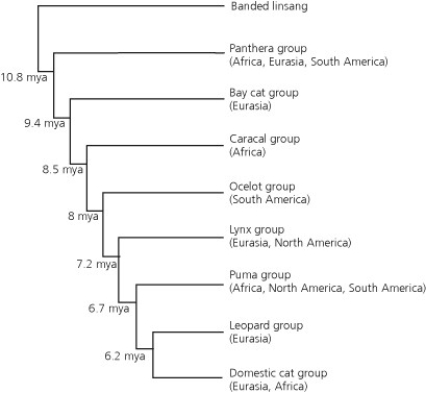The family Felidae (cats) is distributed across Africa, Eurasia, North America, and South America and is hypothesized to have eight major lineages (Panthera, bay cat, caracal, ocelot, lynx, puma, leopard, and domestic cat groups) as shown in this phylogenetic tree, constructed from DNA sequences. Scientists used a molecular clock and fossil evidence to date the divergence of each group. The dates of divergence are provided in the accompanying figure.

-The Manx cat is in the domestic cat group, and the bobcat is in the lynx group. Both have a trait in common: short, stubby tails. According to the phylogeny, which is the most parsimonious explanation for this common trait in these two species of cat?
A) The common ancestor of the Manx cat and bobcat had a short, stubby tail.
B) Horizontal gene transfer between the Manx cat and bobcat occurred.
C) The short, stubby tail evolved independently in these two species.
D) Short, stubby tails were advantageous about 9 million years ago.
Correct Answer:
Verified
Q78: Which of the following is an example
Q79: According to the accompanying figure, if a
Q80: A(n) _ has been used to estimate
Q81: The family Felidae (cats) is distributed across
Q82: The family Felidae (cats) is distributed across
Q83: The family Felidae (cats) is distributed across
Q84: The family Felidae (cats) is distributed across
Q86: The first fossil of Archaeopteryx, which lived
Q87: The family Felidae (cats) is distributed across
Q88: The first fossil of Archaeopteryx, which lived
Unlock this Answer For Free Now!
View this answer and more for free by performing one of the following actions

Scan the QR code to install the App and get 2 free unlocks

Unlock quizzes for free by uploading documents